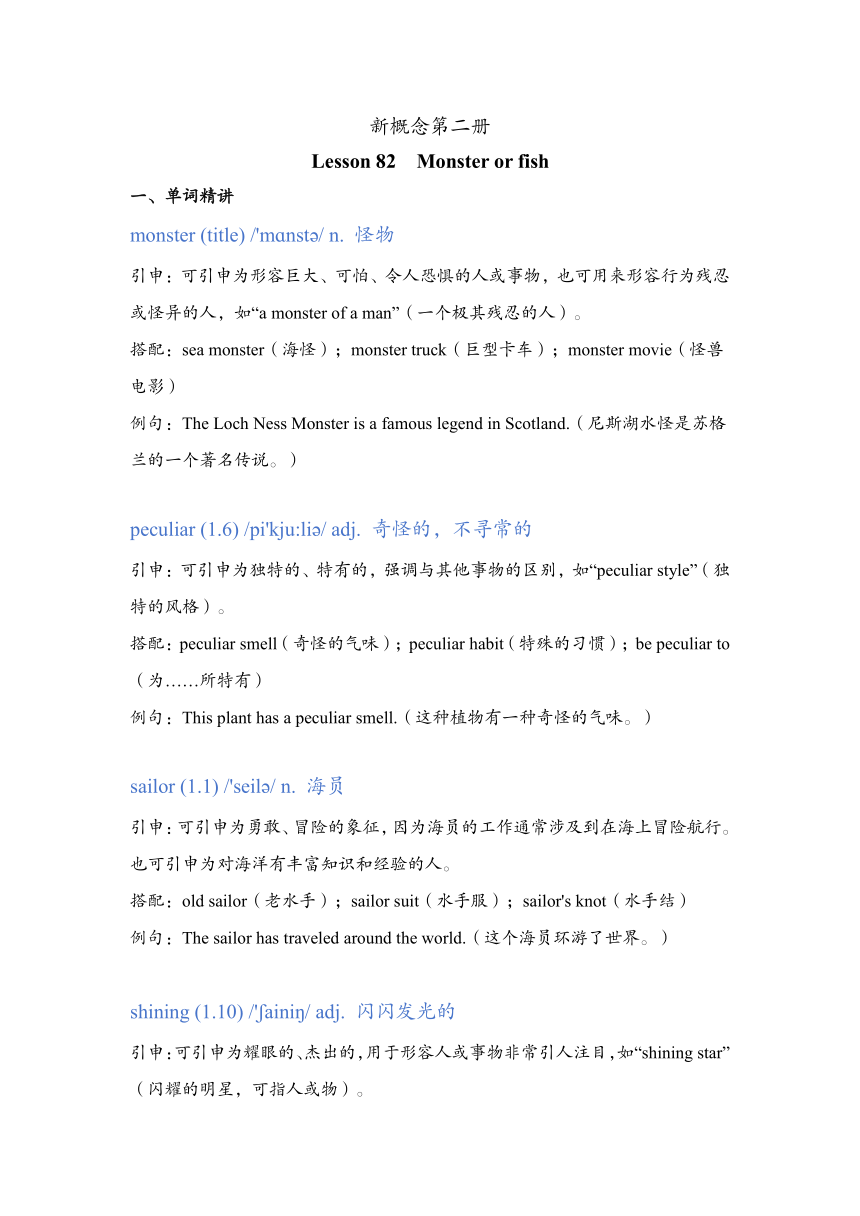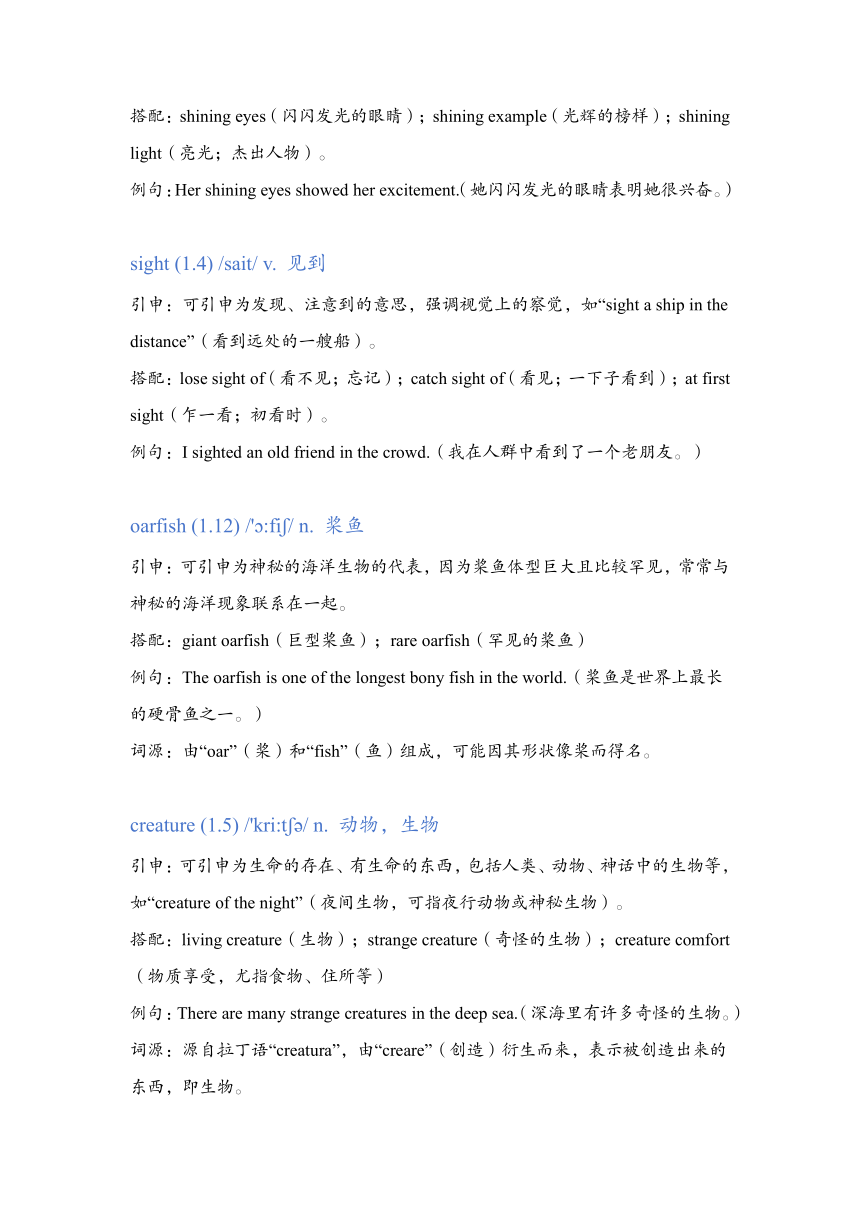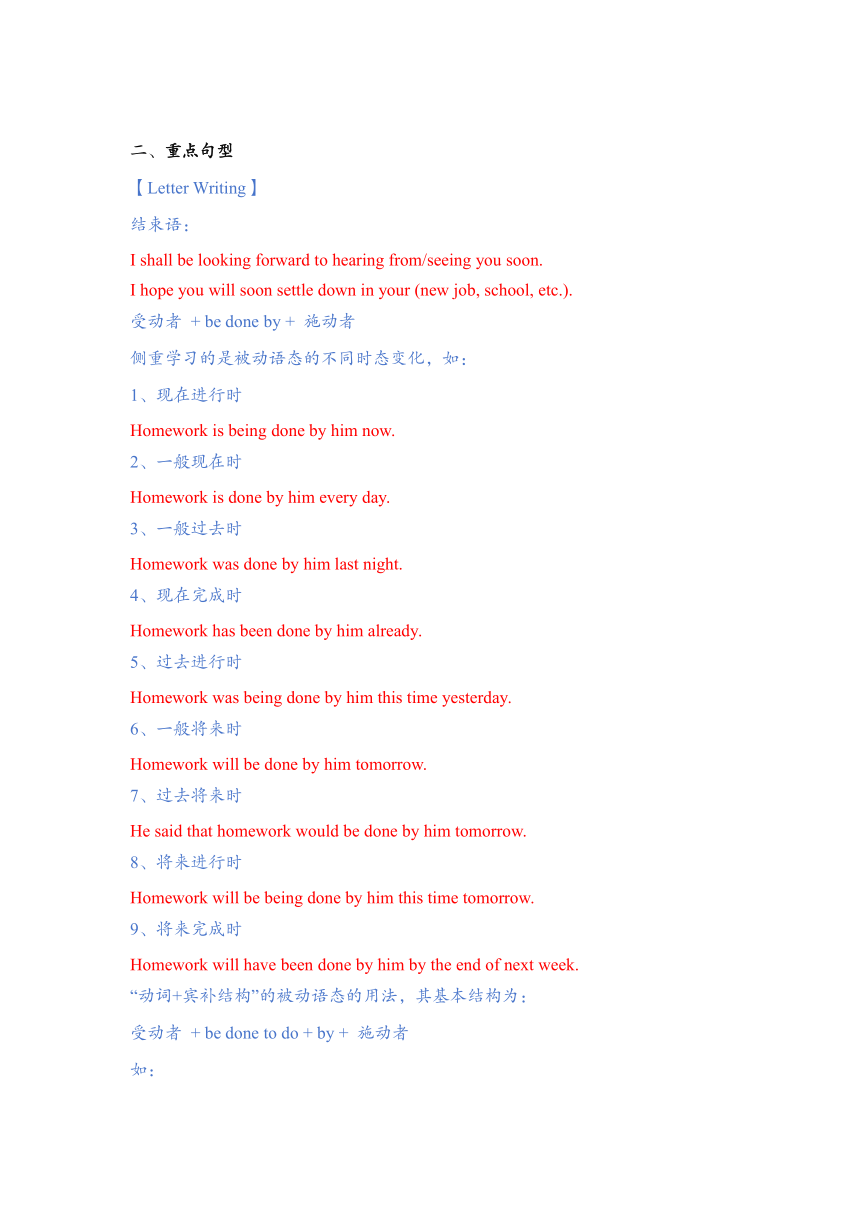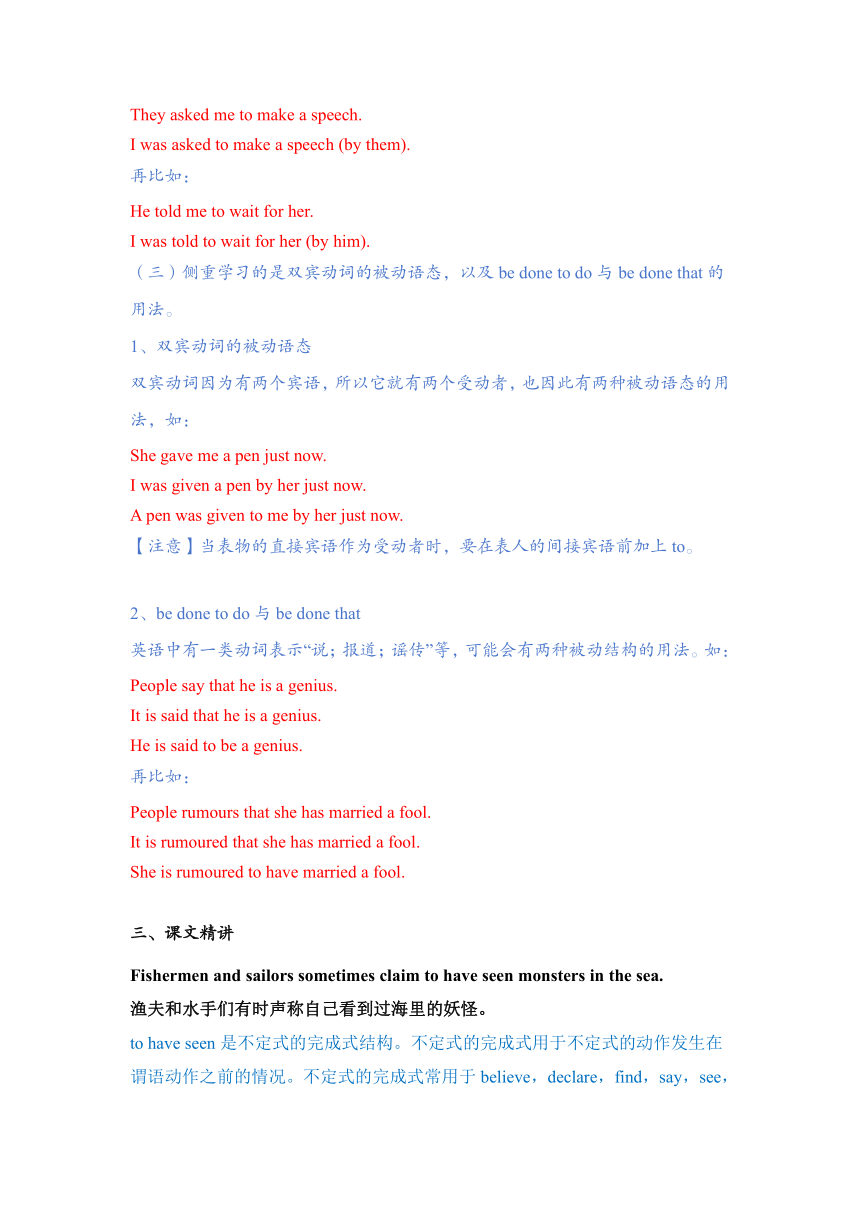 资源简介
资源简介
新概念第二册
Lesson 82 Monster or fish
单词精讲
monster (title) /'mɑnst / n. 怪物
引申:可引申为形容巨大、可怕、令人恐惧的人或事物,也可用来形容行为残忍或怪异的人,如“a monster of a man”(一个极其残忍的人)。
搭配:sea monster(海怪);monster truck(巨型卡车);monster movie(怪兽电影)
例句:The Loch Ness Monster is a famous legend in Scotland.(尼斯湖水怪是苏格兰的一个著名传说。)
peculiar (1.6) /pi'kju:li / adj. 奇怪的,不寻常的
引申:可引申为独特的、特有的,强调与其他事物的区别,如“peculiar style”(独特的风格)。
搭配:peculiar smell(奇怪的气味);peculiar habit(特殊的习惯);be peculiar to(为……所特有)
例句:This plant has a peculiar smell.(这种植物有一种奇怪的气味。)
sailor (1.1) /'seil / n. 海员
引申:可引申为勇敢、冒险的象征,因为海员的工作通常涉及到在海上冒险航行。也可引申为对海洋有丰富知识和经验的人。
搭配:old sailor(老水手);sailor suit(水手服);sailor's knot(水手结)
例句:The sailor has traveled around the world.(这个海员环游了世界。)
shining (1.10) /' aini / adj. 闪闪发光的
引申:可引申为耀眼的、杰出的,用于形容人或事物非常引人注目,如“shining star”(闪耀的明星,可指人或物)。
搭配:shining eyes(闪闪发光的眼睛);shining example(光辉的榜样);shining light(亮光;杰出人物)。
例句:Her shining eyes showed her excitement.(她闪闪发光的眼睛表明她很兴奋。)
sight (1.4) /sait/ v. 见到
引申:可引申为发现、注意到的意思,强调视觉上的察觉,如“sight a ship in the distance”(看到远处的一艘船)。
搭配:lose sight of(看不见;忘记);catch sight of(看见;一下子看到);at first sight(乍一看;初看时)。
例句:I sighted an old friend in the crowd.(我在人群中看到了一个老朋友。)
oarfish (1.12) /' :fi / n. 桨鱼
引申:可引申为神秘的海洋生物的代表,因为桨鱼体型巨大且比较罕见,常常与神秘的海洋现象联系在一起。
搭配:giant oarfish(巨型桨鱼);rare oarfish(罕见的桨鱼)
例句:The oarfish is one of the longest bony fish in the world.(桨鱼是世界上最长的硬骨鱼之一。)
词源:由“oar”(桨)和“fish”(鱼)组成,可能因其形状像桨而得名。
creature (1.5) /'kri:t / n. 动物,生物
引申:可引申为生命的存在、有生命的东西,包括人类、动物、神话中的生物等,如“creature of the night”(夜间生物,可指夜行动物或神秘生物)。
搭配:living creature(生物);strange creature(奇怪的生物);creature comfort(物质享受,尤指食物、住所等)
例句:There are many strange creatures in the deep sea.(深海里有许多奇怪的生物。)
词源:源自拉丁语“creatura”,由“creare”(创造)衍生而来,表示被创造出来的东西,即生物。
重点句型
【Letter Writing】
结束语:
I shall be looking forward to hearing from/seeing you soon.
I hope you will soon settle down in your (new job, school, etc.).
受动者 + be done by + 施动者
侧重学习的是被动语态的不同时态变化,如:
1、现在进行时
Homework is being done by him now.
2、一般现在时
Homework is done by him every day.
3、一般过去时
Homework was done by him last night.
4、现在完成时
Homework has been done by him already.
5、过去进行时
Homework was being done by him this time yesterday.
6、一般将来时
Homework will be done by him tomorrow.
7、过去将来时
He said that homework would be done by him tomorrow.
8、将来进行时
Homework will be being done by him this time tomorrow.
9、将来完成时
Homework will have been done by him by the end of next week.
“动词+宾补结构”的被动语态的用法,其基本结构为:
受动者 + be done to do + by + 施动者
如:
They asked me to make a speech.
I was asked to make a speech (by them).
再比如:
He told me to wait for her.
I was told to wait for her (by him).
(三)侧重学习的是双宾动词的被动语态,以及be done to do与be done that的用法。
1、双宾动词的被动语态
双宾动词因为有两个宾语,所以它就有两个受动者,也因此有两种被动语态的用法,如:
She gave me a pen just now.
I was given a pen by her just now.
A pen was given to me by her just now.
【注意】当表物的直接宾语作为受动者时,要在表人的间接宾语前加上to。
2、be done to do与be done that
英语中有一类动词表示“说;报道;谣传”等,可能会有两种被动结构的用法。如:
People say that he is a genius.
It is said that he is a genius.
He is said to be a genius.
再比如:
People rumours that she has married a fool.
It is rumoured that she has married a fool.
She is rumoured to have married a fool.
课文精讲
Fishermen and sailors sometimes claim to have seen monsters in the sea.
渔夫和水手们有时声称自己看到过海里的妖怪。
to have seen是不定式的完成式结构。不定式的完成式用于不定式的动作发生在谓语动作之前的情况。不定式的完成式常用于believe,declare,find,say,see,know,think,understand等动词之后(这些动词常用被动语态):
I’m sorry to have taken up so much of your time.
He is thought/believed to have been killed in an air crash.
I meant/intended to have invited him, but I forgot to do so.
我本想/本打算邀请他的,可是我忘记了。
I hope/plan to have finished by 12.
我希望/计划到12点钟以前就已完成。(相当于将来完成时)
Though people have often laughed at stories told by seamen, it is now known that many of these monsters which have at times been sighted are simply strange fish.
虽然人们常常对水手们讲的故事付诸一笑,但现在看来,人们有时看到的这些“妖怪”很多不过是些奇怪的鱼。
“laugh at”是固定短语,意为“嘲笑”
例如:Don't laugh at others' mistakes.(不要嘲笑别人的错误。)
at times 有时,偶尔
At times I feel that he is not honest.
Occasionally, unusual creatures are washed to the shore, but they are rarely caught out at sea.
一些异常的生物偶尔会被冲到岸上来,但它们在海上却极少能被捕到。
out at sea 在远海,在外海
Don’t sail out to sea in this weather.
Some time ago, however, a peculiar fish was caught near Madagascar.
然而不久前,在马达加斯加附近的海里却捕到了一条奇怪的鱼。
这是一个简单句。“Some time ago”是时间状语,表示过去的某个时间。“however”是插入语,表示转折。“a peculiar fish”是主语,“was caught”是一般过去时的被动语态,表示被捕获的动作,“near Madagascar”是介词短语作地点状语。
“peculiar”表示奇怪的、不寻常的,例如:This plant has a peculiar shape.(这种植物形状奇特。)
Realizing that this was no ordinary fish, the fisherman made every effort not to damage it in any way.
一条小渔船被一条咬住钩的强壮的大鱼拖到了几英里以外的海面上。
这是一个复合句。“A small fishing boat was carried miles out to sea by the powerful fish”是主句,是一个一般过去时的被动语态句子,“A small fishing boat”是主语,“was carried”是谓语,表示被拖着走的动作,“miles out to sea”是地点状语,“by the powerful fish”是动作的执行者。“as it pulled on the line”是时间状语从句,“it”是从句的主语,“pulled on”是谓语,表示拉(鱼线)的动作,“the line”是宾语。
“pull on”表示拉、拽,例如:The horse pulled on the rope.(马拉着绳子。)
no的否定意味比not (a/an)要重(用于名词或形容词之前、系动词be之后)
They are no friends of ours. 他们根本不是我们的朋友。
This is no easy work. 这绝对不是件容易干的活。
Realizing that this was no ordinary fish, the fisherman made every effort not to damage it in any way.
那位渔民意识到这根本不是一条普通的鱼,于是千方百计不让它受到丝毫伤害。
这是一个复合句。“Realizing that this was no ordinary fish”是现在分词短语作原因状语,其中“Realizing”是现在分词,“that this was no ordinary fish”是宾语从句,“the fisherman made every effort not to damage it in any way”是主句,“the fisherman”是主语,“made every effort”是谓语,表示尽一切努力的动作,“not to damage it in any way”是不定式短语作目的状语。
“make every effort”是固定短语,意为“尽一切努力”,例如:We should make every effort to protect the environment.(我们应该尽一切努力保护环境。)
When it was eventually brought to shore, it was found to be over thirteen feet long.当终于把它弄上岸后,人们发现它身长超过了13英尺。
这是一个复合句。“When it was eventually brought to shore”是时间状语从句,“it”是从句的主语,“was eventually brought”是一般过去时的被动语态,表示被带到岸上的动作,“to shore”是地点状语。“it was found to be over thirteen feet long”是主句,“it”是主语,“was found”是一般过去时的被动语态,表示被发现的动作,“to be over thirteen feet long”是不定式短语作主语补足语。
“eventually”表示最终、终于,例如:He eventually passed the exam.(他最终通过了考试。)
It had a head like a horse, big blue eyes, shining silver skin, and a bright red tail.
它长着一个像马一样的头,有着大的蓝眼睛和闪闪发光的银色皮肤,还有一条鲜红色的尾巴。
这是一个简单句。“It”是主语,“had”是谓语,表示拥有的动作,“a head like a horse, big blue eyes, shining silver skin, and a bright red tail”是并列的宾语,描述这条鱼的特征。
“shining”表示闪闪发光的,例如:The shining diamond attracted everyone's attention.(闪闪发光的钻石吸引了每个人的注意。)
The fish, which has since been sent to a museum where it is being examined by a scientist, is called an oarfish.
此鱼叫桨鱼,被送进了博物馆,现正接受一位科学家的检查。
这是一个复合句。“The fish is called an oarfish”是主句,“The fish”是主语,“is called”是一般现在时的被动语态,表示被叫做的动作,“an oarfish”是宾语。“which has since been sent to a museum where it is being examined by a scientist”是定语从句,修饰“the fish”,其中“which”是关系代词,“has since been sent”是现在完成时的被动语态,表示自从被送到的动作,“to a museum”是地点状语,“where it is being examined by a scientist”是定语从句修饰“museum”,“it”是从句的主语,“is being examined”是现在进行时的被动语态,表示正在被检查的动作,“by a scientist”是动作的执行者。
“examine”表示检查、检验,例如:The doctor examined the patient carefully.(医生仔细检查了病人。)
Such creatures have rarely been seen alive by man as they live at a depth of six hundred feet.
人们很少能看到活着的这类动物,因为它们生活在600英尺深的水下。
creature指包含人在内的“生物,动物”。指人时它可以表示怜爱等感情,多用于指女性:
The poor creature has suffered a lot during that time.
“depth”表示深度
例如:The pool has a depth of two meters.(这个水池有两米深。)
展开更多......
收起↑
 资源预览
资源预览




 资源预览
资源预览



